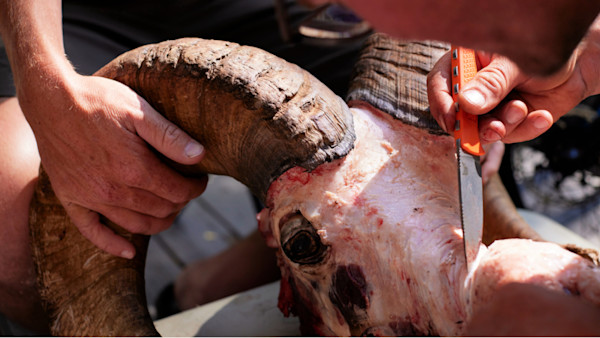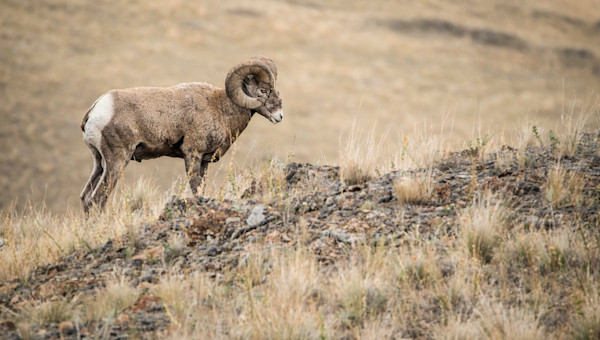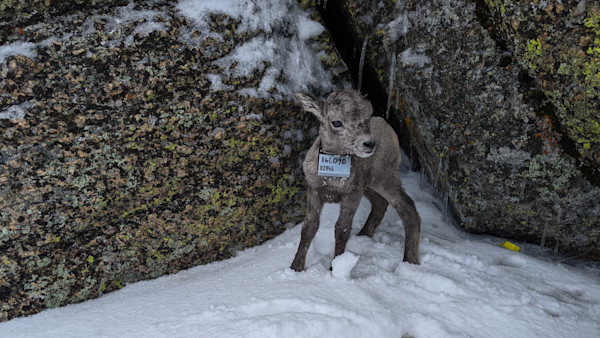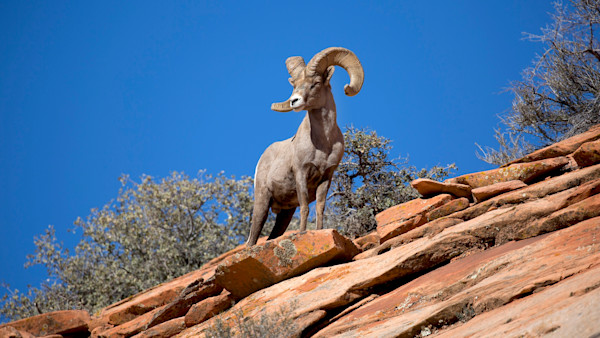
Wild bighorn and thinhorn sheep are unlike nearly every other big game animal in North America when it comes to historical population dynamics. While bison, elk, turkeys, and several species of waterfowl saw their lowest populations at the turn of the 20th century, bighorn sheep populations cratered decades later. Bighorns enjoyed some protections from human encroachment in some of the most inhospitable regions of the country, but eventually succumbed to overhunting and habitat loss.
Today, with the dedication of federal, state, and tribal wildlife agencies, as well as nonprofit organizations like the Wild Sheep Foundation, wild sheep are back on the rise. But they face a gauntlet of threats to their survival.
Americans appreciate wool and lamb meat, and public land grazing plays an important role in supporting robust rural economies. But unfortunately, one of the biggest threats to bighorn sheep—and, by extension, the future of sheep hunting—is a form of pneumonia transmitted by domestic stock.
Known as Mycoplasma ovipneumoniae, or “M.ovi” for short, this disease is nearly always fatal to young bighorns. In a matter of a few years, even the most robust bands of wild bighorn sheep can be decimated by M.ovi as crops of lambs die before their first birthday. There is no cure for the disease in wild populations and current medication isn’t cost-effective for woolgrowers.
There is a relatively simple solution: Keep wild sheep and domestic sheep away from each other. But in practice, in policy, and in law, this issue is far more complicated. The answer to whether domestic sheep belong on public lands is notoriously difficult to discern.
Too Close for Comfort For the better part of the last few centuries, domestic sheep have grazed on lands now held in the public trust, turning excess forage into socks, sweaters, and meat. Under the Federal Land Policy and Management Act (FLPMA) and the National Forest Management Act (NFMA), the Bureau of Land Management and the U.S. Forest Service were both mandated to manage lands for multiple uses, including grazing, oil and gas development, timber harvest, mining, recreation, and wildlife.
The text of both of those laws is boring enough to put even the most caffeinated lawyers to sleep. However, the acts dictate who gets to do what on our public lands. Where these statutes lack in detail or clarity, often they defer to agency staff. This is usually a good thing because it puts highly trained professionals in charge of managing natural resources. But sometimes these laws cause conflict around competing federal land uses.
In 2016, the BLM started ensuring that wildlife disease gets its due consideration in management action. However, as of right now, the USFS has not fully assessed or mitigated risks to wild bighorns from M.ovi. But since both agencies are required to make lands available for both wildlife habitat and grazing under FLPMA and NFMA, this legally mandated coexistence of domestic grazing allotments and wild sheep summer range means lots of sheep end up close together during the warmer months.
For wild sheep conservationists, this is a big problem.
“One of the greatest threats to our mission of putting and keeping wild sheep on the mountain is that of M.ovi,” Wild Sheep Foundation Director of Marketing and Communications Keith Balfourd told MeatEater. “We’ve had success working with public land managers and some woolgrowers on the ground to mitigate the effects of this disease locally, but it is extremely expensive, and each dollar we spend on dealing with this disease is a dollar we could be spending on a translocation or habitat project.”
Ultimately, Balfourd recognizes the importance of keeping both domestic and wild sheep safe and on good grazing land.
“We are hopeful and confident that we can find solutions to this issue that protect the wild sheep resource from exposure to the pathogen while recognizing the interests of domestic sheep growers,” he said.
But that’s easier said than done. This situation isn’t helped by the fact that raising sheep is an awfully tough business these days. Margins are tight, labor is expensive, and kids and grandkids are increasingly disinterested in continuing generational family ranching operations.
“We recognize that this disease issue poses significant challenges for wild sheep, but our research suggests that a minimum 400,000 domestic sheep, and the families who raise and care for them, may be affected by M.ovi-related impacts too,” American Sheep Industry Association Senior Policy and Information Officer Chase Adams told MeatEater. “The effects are serious, not only on sheep operators and their employees, but also meat packing plants and woolen mills.”
There might be some room for compromise. One potential solution is for conservationists to buy grazing rights on pastures of public land directly from woolgrowers, which can be a financially viable option for the woolgrowers who are either seeking to retire or offload parcels where M.ovi is known to occur. Unfortunately, these buyouts are very expensive and federal land management agencies aren’t always able to ensure that bought-out pastures will remain unoccupied. Sometimes sheep producers are willing to trade pastures with cattle ranchers who don’t have to worry about the disease, but this solution isn’t always available to decision-makers.
Ground-Level Impacts Beyond the federal government’s role in managing grazing allotments on BLM and USFS land, where most wild sheep spend most of their time, state and tribal wildlife agencies must contend with the impacts of M.ovi on wild sheep under their jurisdiction.
When Jeff Cole began his career as a wildlife biologist at the Navajo Nation Fish & Wildlife Department in 1989, there weren’t many bighorns on the landscape. Today, there are three distinct herds of desert bighorns under his agency’s stewardship, but two of those bands have active cases of M.ovi and their populations are suffering. These declines have deep impacts.
“Desert bighorn sheep play an important role in Diné culture. Meat from our hunts is shared among members of our communities, while the horns and other parts of the sheep are used in ceremony,” Cole said. “Before the sheep were brought back, our people didn’t have an avenue to access these animals. Now, their presence on the landscape is threatened again.”
The tribe sells or auctions tags for desert bighorn sheep hunting to non-tribal members to raise money for the agency to help mitigate these risks and maintain healthy populations of wild sheep. State wildlife agencies do the same. And beyond funding these management and conservation efforts, wild sheep hunting is important to local economies.
“Beyond their ecological and cultural importance, wild sheep also support a robust outdoor recreation economy, ranging from outfitters, guides, and equipment dealers to outdoor filmmakers like me,” First Lite ambassador and Running Water Media founder Jordan Budd said.
How Can Hunters Help? Ensuring a future for wild sheep, as well as the rich tradition of domestic stockgrowing, will require innovative solutions from wildlife professionals and ongoing contributions from hunters. Some just get lucky enough to pursue these animals. During the 2021 season, one of those individuals was MeatEater’s own Janis Putelis.
“After a decade of buying preference points and applying for lotteries to hunt wild sheep, I was finally able to hunt bighorns in the Lower 48 when I drew a tag in Colorado,” Janis said. “To be a successful sheep hunter, one must spend countless hours in the field scouting, let alone hunting; this was going to be hard since my unit was a 12-hour drive from my home in Montana. I don’t think the experience has set in yet. Maybe it will someday, but for now I am just incredibly grateful to have spent two weeks in the high country of Colorado.”
The future of sheep hunts like Janis’s are threatened by M.ovi. But when hunters take active roles in supporting wildlife conservation, solutions to problems like wildlife disease are easier to research and fund.
Where Do We Go from Here? For better or for worse, the solution to M.ovi isn’t lingering in the marbled halls of Congress, Department of Agriculture, or Department of Interior. Instead, land managers craft them one allotment at a time, with a map and a grease pen in the basement of a district forest or a BLM field office or at the counter of the local diner. These solutions will likely take the well-being of both domestic herds and wild populations into consideration. After all, according to current federal land management policy, domestic sheep do belong on public lands.
But to protect North America’s bighorn sheep from this disease, conservationists must continue to build coalitions of sheep growers, state and federal agencies, and landowners to keep domestic and wild sheep apart in both time and space. And hunters should continue chasing their wild sheep dreams.
“A lot of people feel like a sheep tag is totally out of reach, but it really can happen,” Janis said. “For those who love the adventure of a Western hunt, there is no better pursuit. Put in for draws, enter in lotteries, and help support wild sheep conservation while you’re at it.”






Conversation